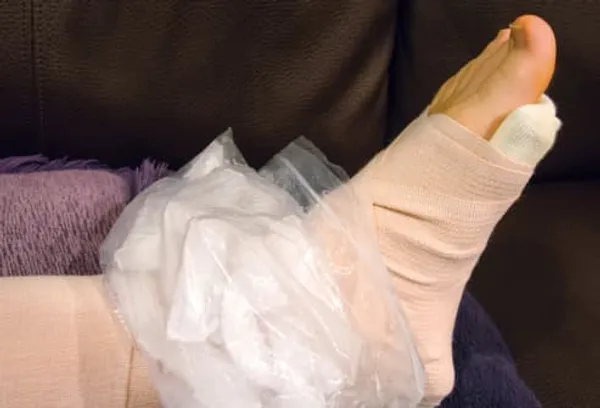What Are the Treatments for Chronic Pain?
The treatments for chronic pain are as diverse as the causes. From over-the-counter and prescription drugs to mind/body techniques to acupuncture, there are a lot of approaches. But when it comes to treating chronic pain, no single technique is guaranteed to produce complete pain relief. Relief may be found by using a combination of treatment options.

Drug Therapy: Nonprescription and Prescription
Milder forms of pain may be relieved by over-the-counter medications such as Tylenol (acetaminophen) or nonsteroidal anti-inflammatory drugs (NSAIDs) such as aspirin, ibuprofen, and naproxen. Both acetaminophen and NSAIDs relieve pain caused by muscle aches and stiffness, and additionally, NSAIDs reduce inflammation (swelling and irritation). Topical pain relievers are also available, such as creams, lotions, or sprays that are applied to the skin in order to relieve pain and inflammation from sore muscles and arthritis.
If over-the-counter drugs do not provide relief, your doctor may prescribe stronger medications, such as muscle relaxants, anti-anxiety drugs (such as diazepam [Valium]), antidepressants (like duloxetine [Cymbalta] for musculoskeletal pain), prescription NSAIDs such as celecoxib (Celebrex), or a short course of stronger painkillers (such as codeine, fentanyl [Actiq, Duragesic], oxycodone and acetaminophen (Percocet, Roxicet, Tylox) or hydrocodone and acetaminophen (Lorcet, Lortab, and Vicodin). A limited number of steroid injections at the site of a joint problem can reduce swelling and inflammation. An epidural might be given for spinal stenosis or lower back pain.
In July 2015, the FDA asked that both prescription and over-the-counter NSAIDs strengthen their warning labels to indicate the potential risk of heart attacks and strokes. The risk increases with higher doses of the drugs. In addition, there is also the possibility of developing bleeding stomach ulcers.
Sometimes, a group of nerves that causes pain to a specific organ or body region can be blocked with local medication. The injection of this nerve-numbing substance is called a nerve block. Although many kinds of nerve blocks exist, this treatment cannot always be used. Often blocks are not possible, are too dangerous, or are not the best treatment for the problem. Your doctor can advise you as to whether this treatment is appropriate for you.
Patient-controlled analgesia (PCA) is another method of pain control. By pushing a button on a computerized pump, the patient is able to self-administer a premeasured dose of pain medicine infused with opioids. The pump is connected to a small tube that allows medicine to be injected intravenously (into a vein), subcutaneously (just under the skin), or into the spinal area. This is often used in the hospital to treat pain in post-traumatic or post-surgical pain as well as terminal cancer pain..

Trigger Point Injections
Trigger point injection is a procedure used to treat painful areas of muscle that contain trigger points, or knots of muscle that form when muscles do not relax. During this procedure, a healthcare professional, using a small needle, injects a local anesthetic that sometimes includes a steroid into a trigger point (sterile salt water is sometimes injected). With the injection, the trigger point is made inactive and the pain is alleviated. Usually, a brief course of treatment will result in sustained relief.
Trigger point injection is used to treat muscle pain in the arms, legs, lower back, and neck. In addition, this approach has been used to treat fibromyalgia, tension headaches, and myofascial pain syndrome (chronic pain involving tissue that surrounds muscle) that does not respond to other treatments.
Onabotulinumtoxina (Botox) is a toxin that blocks signals from the nerves to the muscles. It can also be injected to alleviate chronic migraine headaches. The procedure involves multiple injections around the head and neck every 12 weeks and may alleviate pain for up to three months.
Surgical Implants
When standard medicines and physical therapy fail to offer adequate pain relief, you may be a candidate for a surgical implant to help you control pain. When they are used, which is rare, there are two main types of implants to control pain:
- Intrathecal Drug Delivery. Also called infusion pain pumps or spinal drug delivery systems. The surgeon makes a pocket under the skin that’s large enough to hold a medicine pump. The pump is usually about one inch thick and three inches wide. The surgeon also inserts a catheter, which carries pain medicine from the pump to the intrathecal space around the spinal cord. The implants deliver medicines such as morphine or a muscle relaxant directly to the spinal cord, where pain signals travel. For this reason, intrathecal drug delivery can provide significant pain control with a fraction of the dose that would be required with pills. In addition, the system can cause fewer side effects than oral medications because less medicine is required to control pain.
- Spinal Cord Stimulation Implants. In spinal cord stimulation, low-level electrical signals are transmitted to the spinal cord or to specific nerves to block pain signals from reaching the brain. This method being especially used for back and limb pain. In this procedure, a device that delivers the electrical signals is surgically implanted in the body. A remote control is used by the patient to turn the current off and on or to adjust the intensity of the signals. Some devices cause what’s described as a pleasant, tingling sensation while others do not.
Two kinds of spinal cord stimulation systems are available. Partial and totally implanted units. The unit that is more commonly used is fully implanted. The latter system’s antenna and transmitter are carried outside the body, while the receiver is implanted inside the body
TENS
Transcutaneous electrical nerve stimulation therapy, more commonly referred to as TENS, uses electrical stimulation to diminish pain. During the procedure, low-voltage electrical current is delivered through electrodes that are placed on the skin near the source of pain. The electricity from the electrodes stimulates the nerves in an affected area and sends signals to the brain that “scramble” normal pain signals. TENS is not painful and may be an effective therapy to mask pain such as diabetic neuropathy. However, TENS for chronic low back pain is not effective and cannot be recommended, says the American Academy of Neurology (AAN).
Bioelectric Therapy
Bioelectric therapy relieves pain by blocking pain messages to the brain. Bioelectric therapy also prompts the body to produce chemicals called endorphins (endorphins are also released by exercise) that decrease or eliminate painful sensations by blocking the message of pain from being delivered to the brain.
Bioelectric therapy can be used to treat many chronic and acute conditions causing pain, such as back pain, muscle pain, headaches and migraines, arthritis, TMJ disorder, diabetic neuropathy, and scleroderma.
Bioelectric therapy is effective in providing temporary pain control, but it should be used as part of a total pain management program. When used along with conventional pain-relieving medications, bioelectric treatment may allow pain sufferers to reduce their dose of some pain relievers by up to 50%.
Physical Therapy
Physical therapy helps to relieve pain by using special techniques that improve movement and function impaired by an injury or disability. Along with employing stretching, strengthening, and pain-relieving techniques, a physical therapist may use, among other things, TENS to aid treatment.
Exercise
Although resting for short periods can alleviate pain, too much rest may actually increase pain and put you at greater risk of injury when you again attempt movement. Research has shown that regular exercise can diminish pain in the long term by improving muscle tone, strength, and flexibility. Exercise may also cause a release of endorphins, the body’s natural painkillers. Some exercises are easier for certain chronic pain sufferers to perform than others; try swimming, biking, walking, rowing, and yoga.
Psychological Treatment
When you are in pain, you may have feelings of anger, sadness, hopelessness, and/or despair. Pain can alter your personality, disrupt your sleep, and interfere with your work and relationships. In turn, depression and anxiety, lack of sleep, and feelings of stress can all make pain worse. Psychological treatment provides safe, nondrug methods that can treat your pain directly by reducing high levels of physiological stress that often aggravate pain. Psychological treatment also helps improve the indirect consequences of pain by helping you learn how to cope with the many problems associated with pain.
A large part of psychological treatment for pain is education, helping patients acquire skills to manage a very difficult problem.
Alternative Therapies
In the past decade, many people have found relief for their pain in mind-body therapies, acupuncture, and some nutritional supplements. Others use massage, chiropractic and osteopathic (bone) manipulation therapies, therapeutic touch, certain herbal therapies, and dietary approaches to alleviate pain. However, there is little if any scientific evidence supporting these therapies for pain relief.
Mind-Body Therapies
Mind-body therapies are treatments that are meant to help the mind’s ability to affect the functions and symptoms of the body. Mind-body therapies use various approaches including relaxation techniques, meditation, guided imagery, biofeedback, and hypnosis. Relaxation techniques can help alleviate discomfort related to chronic pain.
Visualization may be another worthwhile pain-controlling technique. Try the following exercise: Close your eyes and try to call up a visual image of the pain, giving it shape, color, size, motion. Now try slowly altering this image, replacing it with a more harmonious, pleasing — and smaller — image.
Another approach is to keep a diary of your pain episodes and the causative and corrective factors surrounding them. Review your diary regularly to explore avenues of possible change. Strive to view pain as part of life, not all of it.
Electromyographic (EMG) biofeedback may alert you to the ways in which muscle tension is contributing to your pain and help you learn to control it. Hypnotherapy and self-hypnosis may help you block or transform pain through refocusing techniques. One self-hypnosis strategy, known as glove anesthesia, involves putting yourself in a trance, placing a hand over the painful area, imagining that the hand is relaxed, heavy, and numb, and envisioning these sensations as replacing other, painful feelings in the affected area.
Relaxation techniques such as meditation or yoga have been shown to reduce stress-related pain when they are practiced regularly. The gentle stretching of yoga is particularly good for strengthening muscles without putting additional strain on the body.
- Related:Causes of Shoulder Pain
Acupuncture
Acupuncture is thought to decrease pain by increasing the release of endorphins, chemicals that block pain. Many acu-points are near nerves. When stimulated, these nerves cause a dull ache or feeling of fullness in the muscle. The stimulated muscle sends a message to the central nervous system (the brain and spinal cord), causing the release of endorphins that block the message of pain from being delivered to the brain.
Acupuncture may be useful as an accompanying treatment for many pain-related conditions, including headache, low back pain, menstrual cramps, carpal tunnel syndrome, tennis elbow, fibromyalgia, osteoarthritis (especially of the knee), and myofascial pain. Acupuncture also may be an acceptable alternative to or may be included as part of a comprehensive pain management program.
Chiropractic Treatment and Massage
Chiropractic treatment is the most common nonsurgical treatment for back pain. Improvements of people undergoing chiropractic manipulations were noted in some trials. However, the treatment’s effectiveness in treating chronic back and neck pain has not been supported by compelling evidence from the majority of clinical trials. Further studies are currently assessing the effectiveness of chiropractic care for pain management.
Osteopathic doctors, those with a “D.O.” after their names, are also trained in bone manipulation techniques similar to that of chiropractors.